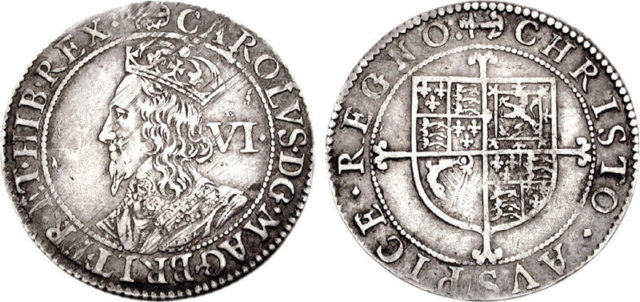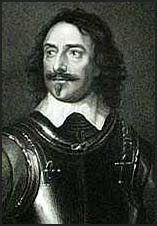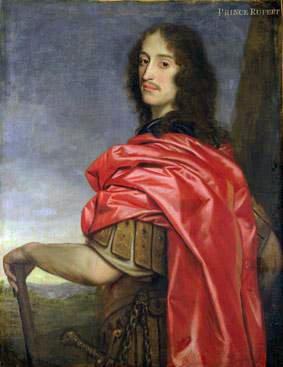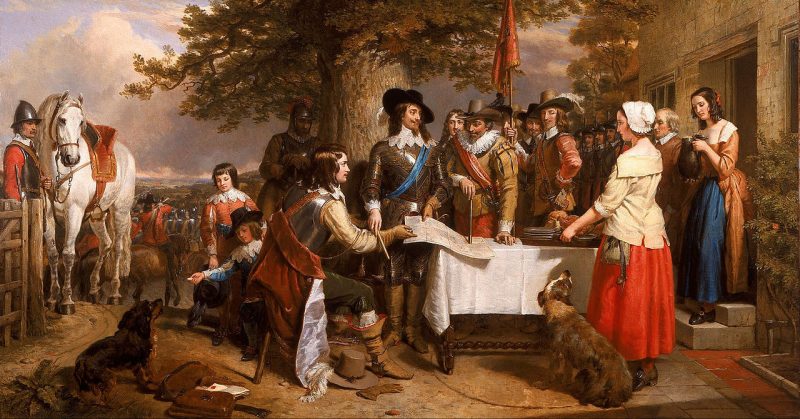War History Online presents this Guest Article by Jemahl Evans
Everyone thought it would all be over by Christmas. Everyone expected a single sharp engagement and the matter would be settled one way of the other – King or Parliament. Everyone was wrong.
The King gathered his army at Shrewsbury on the Welsh border: Pikes, Muskets, Horse, and Ordnance – perhaps 12,500 men in total and sixteen cannons. Charles, I relied upon the nobility and magnates to raise troops from their own purses and estates, just as they had done for centuries. In many ways, the Royal Army in 1642 was the last gasp of the Feudal System.
It was not a structure of recruitment or procurement that could survive the brutality of a civil war, however, in the opening months, it produced a formidable field army particularly strong in Horse and Ordnance. The Royalist Foot were not as well armed, most had no armor, and the quality of their equipment was patchy (one company was said to be armed with nothing but clubs) but the men were fervently loyal to their officers and high in moral.
While King Charles was, in theory, the overall commander, he had appointed Robert Bertie, the Earl of Lyndsey, as his Lieutenant General and actual field commander. Right from the outset of the campaign, Lyndsey was at loggerheads with the King’s 22-year-old nephew, and commander of Horse, Prince Rupert of the Rhine. Rupert, despite his tender years, was a very experienced officer who had fought in the continental wars of religion. He was an innovative cavalry commander, and excellent tactician, but his personality was abrasive, causing heated arguments in the royalist high command.

Parliament’s army was slightly larger in numbers, with more cannon, but with poor quality of Horse and Dragoons when compared to the Cavaliers. Oliver Cromwell – who missed most of the Battle of Edgehill – would say afterward:
“Your troopers are most of them old decayed serving men and tapsters; and their [the Royalists’] troopers are gentlemen’s sons, younger sons and persons of quality; do you think that the spirits of such base and mean fellows [as ours] will ever be able to encounter gentlemen that have honour and courage and resolution in them?”
The strength of the Earl of Essex’s command was in his infantry, built around the London Trained Bands. With the resources of the capital to fund the war, Parliament’s troops were better equipped than the Cavaliers, but morale was not good; rioting and looting accompanied the army as it moved through the Midlands.
Robert Devereux, 3rd Earl of Essex, had been the logical choice for Parliament’s Lord General. He was the senior noble to defy the King, and he had experience of battle on the continent. He was also a cautious commander, who would prioritize not losing over the chance to win, but like Charles I, he had an experienced cadre of officers at his disposal. He led the army first to Northampton, and then on to Worcester. A brief cavalry skirmish at Powick Bridge proved to be the first contact between the two armies, and quickly demonstrated the superiority of the Royalist Horse under Rupert.

The King then moved his army towards London with the Earl of Essex following him. Both commanders hoped to force a battle on favorable terrain. Charles I, Secretary Edward Hyde, later Earl of Clarendon, would write in his memoirs that the two armies had little knowledge of each other or how close the two forces were, but this is clearly not the case. Both sides had considerable numbers of scouts covering each other’s movements, and the Earl of Essex was receiving regular updates from a spy in the Royal command. The Roundhead army followed the King towards Banbury, stopping at the small Warwickshire village of Kineton. The Roundhead spy, known as Mr. Blake, was Prince Rupert’s Secretary and therefore very well informed, but Rupert’s speed of action on the morning of the 22nd October still caught Essex by surprise on his way to Sunday morning service.
Rupert, with a typical dash, had marched with his cavalry to seize the high ground above the village of Kineton by around 8 am – a long ridge and escarpment known as the Edgehill – but the rest of the Royalist army took the time to reach him and deploy. Parliament’s army was also spread out over miles rather than concentrated, and it would take some hours for most of their units to come in – some would miss the battle completely including most of the artillery train.
The traditional deployment of the two armies as shown the map has been challenged by recent archaeological investigations of the battlefield. This new research has shifted the deployment anti-clockwise by about 45 degrees on an almost north – south alignment rather than southwest – northeast. Both sides deployed with cavalry on the flanks – Horse and Dragoons – while the Pike blocks Muskets at their flanks formed battle lines in the center. By midday, both armies had completed their deployment, but neither made any move to attack.
The royalist army slowly moved down from the Edgehill escarpment, dragging their great cannon with them as Essex watched on. At around two in the afternoon the sight of King Charles goaded Parliament’s cannon into opening fire, and the Royalist cannon soon replied. The eminent military historian Richard Holmes postulated that the opening barrage also saw inexperienced men and horses bolt in terror at the noise. The artillery duel was largely ineffective, and Royalist cavalry on the right flank moved to attack.

It is here that Prince Rupert’s innovative leadership came to the fore. Instead of using the cavalry as a mobile firing platform to skirmish at a distance, as was the usual tactic for Horse in the first half of the seventeenth century, Rupert led his men in a wild charge discharging their pistols at the last moment and engaging with the sword. It should be noted that the other side of Rupert’s personality had caused a split in the Royalist High Command that morning, with the Earl of Lyndsey resigning rather than deal with the prince – Lyndsey was later killed in the battle.
Rupert’s charge swept away the poorly trained and led Roundhead cavalry, but his own units did not have the discipline to halt and reform, charging after their enemy and looting their baggage train in Kineton. On the royalist left flank, the impact of the charge was the same, and very quickly both armies’ cavalry flanks had left the field – chasing each other and the loot. This left Essex with an advantage, both of men and of their quality and equipment. He was also left with a small cavalry reserve which he would use to devastating effect.
The two infantry lines crashed together. The pikes in phalanxes, with musketeers flanking each pike unit and pouring fire into the enemy, pushed against each other in a brutal scrum. Essex’s advantage in Foot was telling, added to this was a resupply of ammunition that kept up a steady fire of musketry, while the Royalists seem to have run out of powder and shot early on in the fight.
The infantry push was brutal hand to hand combat. The Royal standard was captured at one point with the standard bearer’s hand (Sir Edmund Verney) still attached – Verney’s body was never recovered, although the standard was recaptured in the confusion of the fight. As night began to fall, the Roundhead superior armor and relentless musket fire took its toll. Essex launched his small cavalry reserve on an attack on the left flank of the Royalist infantry and pushed the Royalist line back. However, the battle ended as darkness fell with the Royalists falling back to the Edgehill escarpment, while the Roundheads stood on the field until the morning, through a bitterly cold night.
In the immediate aftermath of the battle, the King moved slowly towards Oxford taking the city as his capital, despite Prince Rupert urging him to march on London. Rupert himself led an attack on the Earl of Essex baggage two days after the battle, capturing the Earl’s coach and papers, and also discovering his secretary’s treason. Mr. Blake was promptly hanged as a spy. Despite this, the Earl of Essex was able to hurry back to London before the King, and reinforced by the London Trained Bands, faced off against the Royal Army at Turnham Green just outside the city. King Charles was badly outnumbered, and could not risk a battle against overwhelming odds, retiring instead to Oxford for the winter. Both sides King and Parliament began to plan for a long war that nobody had expected or wanted.
Author: Jemahl Evans has an MA in History and is the author of acclaimed The Last Roundhead Series of novels. Book 2, The Deceitful Light, will be published by Holland House Books in autumn 2017.
